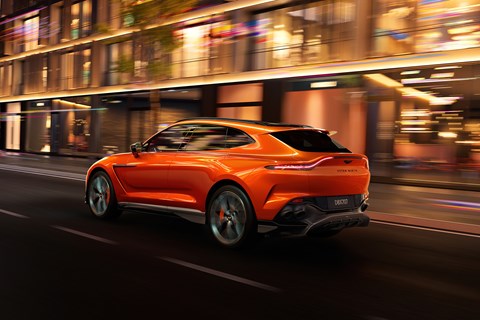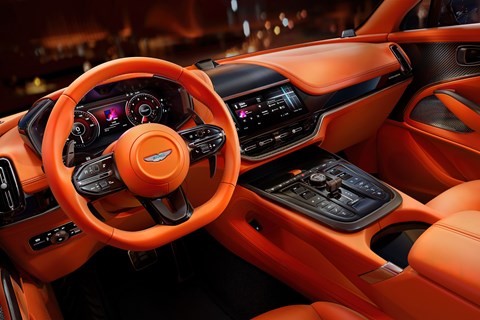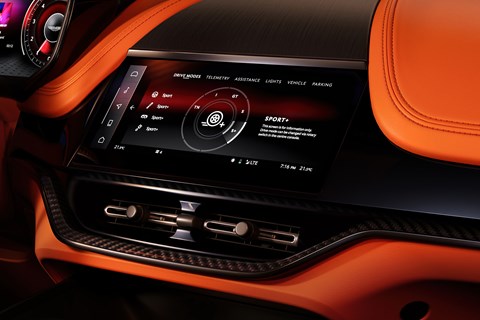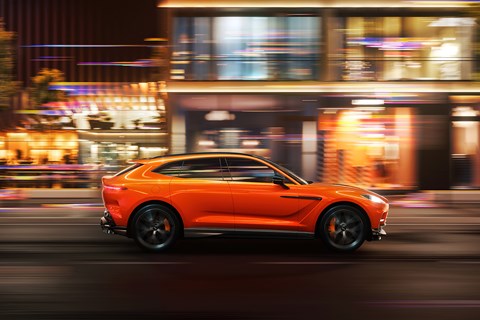► Aston Martin DBX range revised for 2024
► DBX 707 spec becomes only model available
► New touchscreen tech from DB12 slides in
The Aston Martin DBX range is being overhauled for 2024 – and the key adjustments are the standardisation of the brawniest DBX 707 engine, becoming the single powerplant offered on the performance SUV, and the arrival of the latest touchscreen infotainment from the DB12 and other models.
Previously, the 707 was reserved as a top-level trim and at launch in 2022 Aston touted it as ‘the world’s most powerful luxury SUV.’ That claim was helped when Jeep’s Grand Cherokee Trackhawk and Dodge’s Durango SRT Hellcat – both more powerful than the 707 – went off sale in their home markets. Handy, that.
The new 2024 Aston Martin DBX 707 is named after its metric power output: 707hp, equivalent to a colossal 697bhp in imperial horses. The Mercedes-AMG developed 4.0-litre V8 has its torque mountain massaged to 664lb ft, which might explain the prodigious performance on offer.
Gaydon claims its high-performance SUV can sprint to 60mph in just 3.1 seconds and top speed stands at 193mph – both figures unchanged for 2024. It’s significantly faster than the original launch DBX, which made do with ‘only’ 543bhp/516lb ft.
Read our review of the Aston Martin DBX

All of that shove is sent to all four wheels by a nine-speed wet-clutch transmission, modified air suspension and a toughened electronic differential for the rear axle, where in extremis 100 per cent of the power can be sent to the back axle.
Carbon ceramic brakes are standard, too, with Aston saying they remove 40.5kg from the unsprung mass – handy for ride quality and handling. The DBX is made from bonded aluminium, like all Astons, to keep a lid on weight.
Sizeable 22-inch alloys are standard on DBX 707, but customers can upgrade to 23in rims should they wish (and many surely will).
Inside the 2024 Aston Martin DBX 707 interior
Other than dropping the less powerful ‘regular’ V8 model, not much is changing with the engineering spec of the 2024 DBX range. Instead, most of the improvements are focused on the interior.

The latest family infotainment is installed and there’s a comprehensive interior makeover that covers a new steering wheel, redesigned door handles and fresh air vent design. The touchscreen tech is important, bringing Gaydon’s own bespoke user interface (UI) which lets punters use the Aston operating system and smartphone app or Apple CarPlay/Android Auto. We’ve sampled it and the infotainment is a big improvement over the Merc-sourced system that went before.
Being an SUV, there is more space for screen real estate and the driver’s display is 12.3 inches here (1.5in bigger than the DB12 or Vantage’s), while the capacitive 10.25in touchscreen is integrated into the new-look dashboard.
The designers haven’t tried to put too much into the touchscreen, striving to meet ‘Aston Martin’s philosophy of creating the perfect blend between digital and analogue controls.’ This is music to our ears: gear selection, heating and ventilation and driver modes are all controlled with exquisite-to-touch physical buttons.

Naturally, Aston design DNA has been applied to the SUV shape with interesting results. The plush, leather-trimmed cockpit has been extensively developed, according to Aston Martin, to fit almost any kind of driver comfortably. Details like interior storage, rear space and visibility have been at the forefront of the development team’s minds – arguably the first time that’s really been the case in an Aston.
Engineering, specs
Air suspension is standard, allowing the ride height to be dropped or raised by 50mm for off-roading or loading purposes. The triple-chamber air springs can develop 1400Nm of anti-roll force on each axle, suppressing body roll effectively. And it really does work, the DBX’s suspension system is one of the best parts of the dynamic package it offers.

All Aston Martin DBX models are four-wheel drive, while an active central differential and electronically controlled rear e-diff apportions drive front and rear, and side to side, allowing for precise torque vectoring.
Other minor changes to note include pop-out door handles that present when the key is detected nearby and new frameless door mirrors, like on the Aston Martin DB12.
Marco Mattiacci, Aston’s global chief brand and commercial officer, said: ‘With its best-in-class performance and dynamics, world-class design and the highest levels of luxury, the DBX707 immediately established a new ultra-luxury SUV benchmark. Now upgraded with state-of-the-art technology and a completely new interior the DBX707 moves the game on once more, further elevating the standard by which all competitors are judged.’
When can I buy the new 2024 Aston Martin DBX707?
Sales start in the third quarter of 2024 – expect the newcomer to be ready for the UK’s new plate change in September, after a start of production slated for Q2.
No word on prices yet, but you can safely expect them to balloon from the 707’s original cost of £189k two years ago. The regular, detuned DBX cost from £158k when it launched as Aston’s first SUV.
The 707 proved so popular, making up the majority of DBX sales, giving Aston Martin the confidence to make it the default model. It’s a clever step to shore up profit margins and put some clear water between its offering and those of upstart German brands and Range Rover, whose RRP and performance creds creep ever nearer to Aston territory…
Watch our pre-facelift video review of the Aston Martin DBX below.